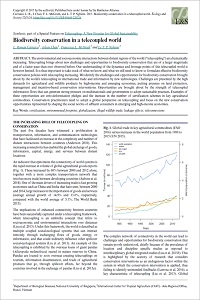Biodiversity conservation in a telecoupled world
The environmental and socioeconomic interactions between distant regions of the world (“telecoupling”) are dramatically increasing. Telecoupling brings about new challenges and opportunities to biodiversity conservation that are of a larger magnitude and of a faster pace than ever observed before. Our understanding of the dynamics and leverage points of this telecoupled world is however limited. It is thus important to take stock of what we know and what we still need to know to formulate effective biodiversity conservation policies with telecoupling increasing. We identify the challenges and opportunities for biodiversity conservation brought about by the world’s telecoupling in international trade and information by new technologies. Challenges are presented by the high demands for agricultural and wildlife products by high-income and emerging economies, putting pressure on land protection, management and incentive-based conservation interventions. Opportunities are brought about by the strength of telecoupled information flows that can generate strong pressure on multinationals and governments to adopt sustainable practices. Examples of these opportunities are zero-deforestation pledges and the increase in the number of certification schemes in key agricultural commodities. Conservation practitioners need to adopt a global perspective on telecoupling and focus on the new conservation opportunities represented by shaping the social norms of affluent consumers in emerging and high-income economies.

